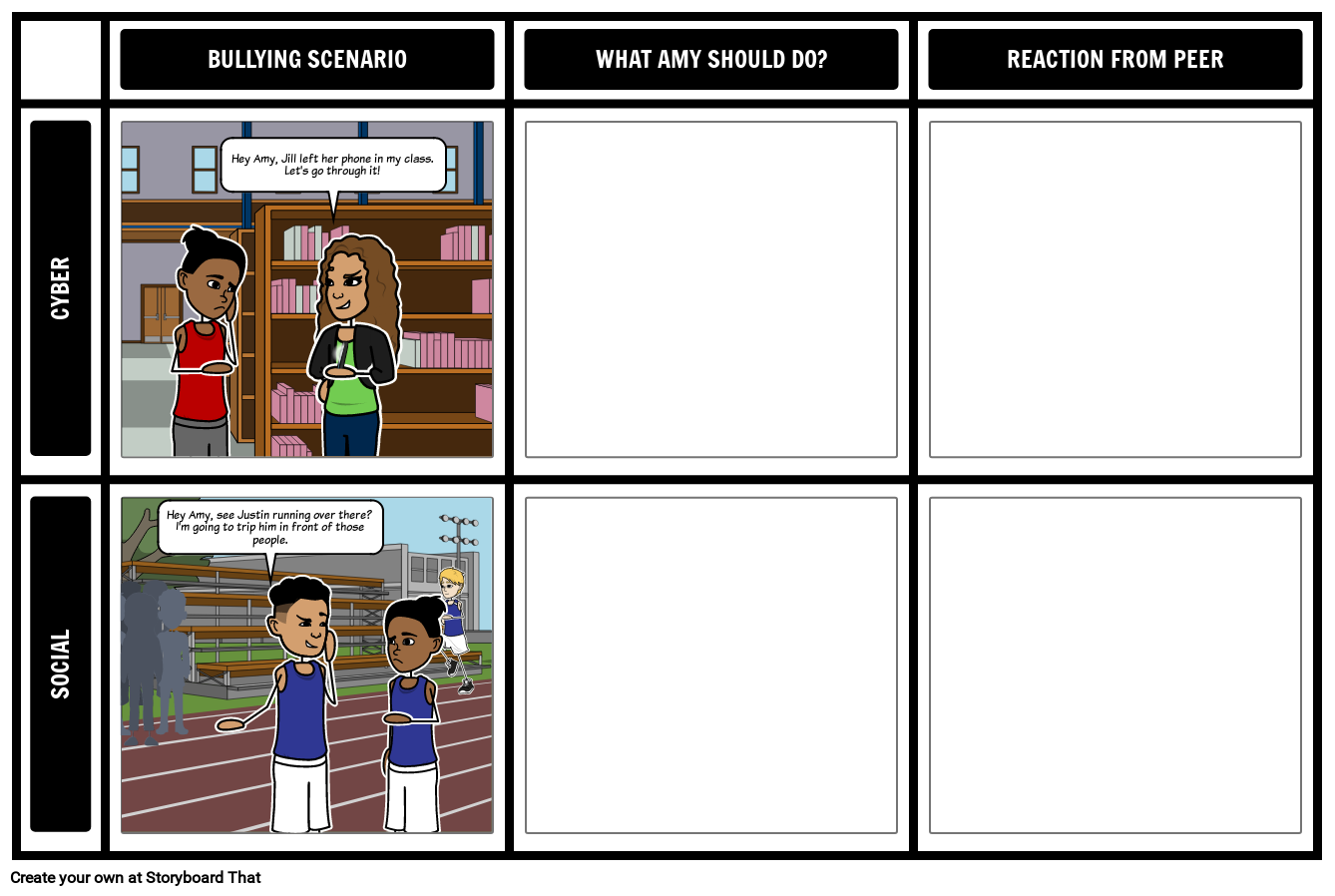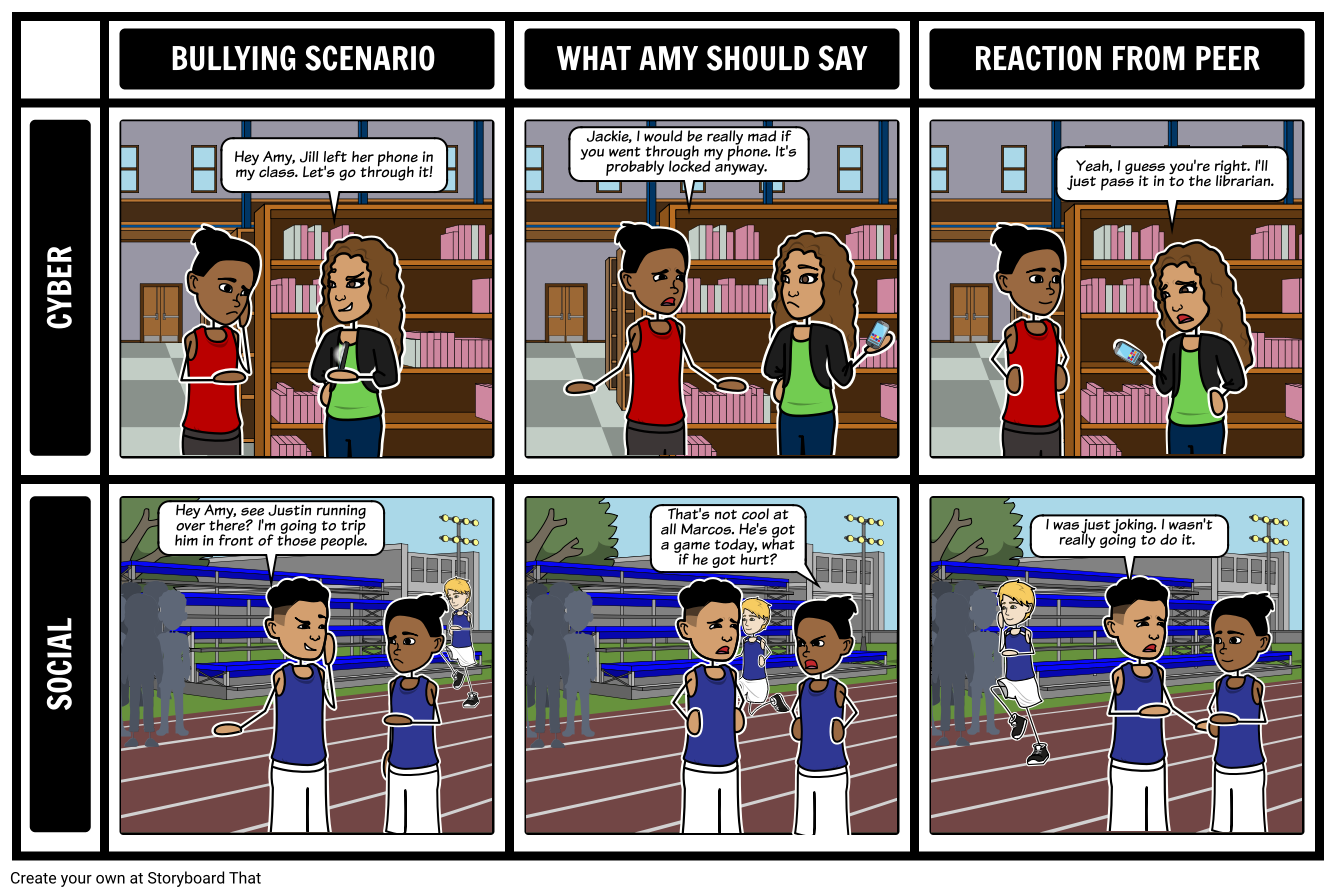The average percentage of visual learners sitting in your classroom is 65%. This may also mean they find it more helpful to express their understanding visually. Storyboard That is a wonderful tool that can help reach the majority of your students in an original and creative manner. It can be used as a fun assessment tool, discussion starter, or presentation format for students and teachers. Students will be able to create their work in a timely manner and connect better with the content and the lesson's learning objectives.
The goal of most scenario activities in the health class is real-life practice and application. Several health education lessons throughout a school year will include scenarios of some sort, and they're an important category of activities. Scenarios allow students to work through problems in a real-life setting without necessarily having to do improv in front of the class. Using Storyboard That, teachers can have students work through different scenarios, imagine themselves in them, or create their own comics. When they create characters that look like themselves or others, students may be creating a different connection that was not there before. Building connections with content is an underlying educational goal for helping students retain content.
Ideas for Health Class Activities
Storyboard That provides students who lack the ability to put their thoughts and ideas into a drawing or visuals the opportunity to be creative. Through manipulating scenes and changing characters' movement and facial expression, Storyboard That gives students a very powerful tool that can help them express messages and thoughts in a way they may not have been able to before. When students feel successful, they are more internally motivated to achieve more things. No one wants to fail or be frustrated in their own capabilities.
Creativity has always been a difficult aspect to measurable in a rubric. Taking out the need to create the art gives every student the ability to be creative and allows each teacher to see the level of effort put into the work. It also allows for consistency with relation to measurability. When each student has the same tools, we have an even playing field. Let’s see how far they can take Storyboard That in your class!
Vocabulary and Terminology
Introducing terminology usually takes place at the beginning of a lesson or unit, and is a fundamental building block for trying to understanding broad concepts. At times, some definitions may blend together for students, so incorporating a visual aid for these terms may assist students with understanding and internalizing the differences. When using Storyboard That, you’ll be able to combine more than one dynamic of understanding in an attention-grabbing way. The example below shows an activity using visual learning with verbal learning. It's a highly effective method for vocabulary introduction and retention.
Relationship Scenarios
Most health education curriculum usually contains subjects and content that may be sensitive and challenge social norms. I believe this is what makes Health such an important subject for students. Using Storyboard That as a way to introduce and elaborate on tough topics through visual creation will allow for seamless instruction. Some students may feel apprehensive about covering these subjects. Using stories to tell messages is a great way to help ease the tension. Other students may feel a disconnect from certain cultures or beliefs. Again, Storyboard That’s personalization of characters, scenes, and objects allows for anyone to connect with your content.
Decision Making & Impacts
The T-Chart layout works perfectly when used during a nutrition unit. When discussing the impact of decisions like healthier eating habits or physical activity, you’ll be able to have your students compare outcomes side-by-side. Creating visual aids to help students with the essential nutrients through the spider map layout will reach your visual learners. Using that same activity as a summative assessment for your nutrition unit may spice up a dull topic for some students. Whether or not the students are individually working and sharing work or working in a group setting, they’ll be visualizing and creating outcomes of a healthy lifestyle.
Decision Making
Practicing decision making and analyzing possible outcomes in a safe format is especially imperative during a unit on addiction or eating disorders. When students are faced with decisions in life, they will have to make their minds up quickly. Practicing positive decision making will help students develop the skills to implement quick and positive decision making in the real world.
I sometimes find myself struggling to give students relevant scenarios and keep up with what young people are concerned about. With Storyboard That, students are able to create their own scenes with their own ideas; students are creating the realistic situation the teachers are looking for. Not only does this make the learning more personable, it allows teachers to be better aware of the things going on around them.
In my own classroom, I’ve used a cartoon strip as a summative project for my students. The activity asked them to create a refusal skill scenario where someone refused peer pressure. The students enjoyed this project because they were able to create something for a grade instead of having to writing an essay. Because of the excellent, expressive art that on Storyboard That, students can personalize their creations. Give your students the ability to express themselves in a fun way while meeting curriculum standards with Storyboard That.
And if you're looking to create custom resources for your classroom, check out the plethora of worksheet templates and poster templates available. I have found these immensely helpful in tailoring additional practice activities to the students I'm currently teaching.
How to Role-Play Communication Skills in Health Scenarios
Select Health Scenarios:
Choose relevant health scenarios that require effective communication, such as a doctor-patient consultation, peer conflict resolution, or discussing sensitive health topics.
Assign Roles and Provide Background Information:
Assign roles to students, specifying the characters they will portray in the scenarios. Provide background information for each character, including their perspectives, goals, and any relevant medical or health history.
Set the Scene and Establish Objectives:
Describe the scenario setting and context to create a realistic environment. Clearly define the objectives of the role-play, such as effective listening, empathy, clear communication, or problem-solving.
Conduct the Role-Play:
Allow students time to prepare for their roles, encouraging them to think about their character's motivations and possible communication strategies. Facilitate the role-play, ensuring that each student has an opportunity to actively participate and engage in the scenario. Provide guidance and support as needed, offering suggestions for improving communication skills during the role-play.
Debrief and Reflect:
Facilitate a debriefing discussion immediately after each role-play, allowing students to reflect on their experiences. Encourage students to share their observations, challenges, and successes during the role-play. Discuss effective communication techniques demonstrated during the role-play and how they can be applied in real-life situations.
Provide Feedback and Practice:
Offer constructive feedback to students, highlighting their strengths and areas for improvement in their communication skills. Encourage students to practice and refine their communication skills through additional role-plays or real-life scenarios. Provide resources, such as communication tips or scenarios, for students to further develop their communication skills.
Frequently Asked Questions about Health and Wellness
What is Storyboard That, and how can it be used in a health classroom?
Storyboard That is a tool that can help teachers reach visual learners in their health class through creating comics or storyboards as a fun assessment tool, discussion starter, or presentation format for students and teachers.
How can scenarios be used in a health class, and how can Storyboard That help with this?
Scenarios in health class provide students with real-life practice and application of their learning. Storyboard That can be used to create scenarios that allow students to work through problems in a real-life setting without necessarily having to do improv in front of the class. Students can create characters that look like themselves or others to build connections with content, which helps them retain information better.
How can Storyboard That help students who struggle to express their ideas visually?
Storyboard That provides students with a tool to express their ideas and thoughts in a creative way that they may not have been able to do before. It allows them to manipulate scenes, change characters' movements and facial expressions, and create messages and thoughts in a way that suits them.
How can Storyboard That help teachers with vocabulary and terminology instruction in a health class?
Storyboard That can be used to introduce and explain health-related terminology using visual aids to assist students with understanding and internalizing differences. This allows teachers to combine more than one dynamic of understanding in an attention-grabbing way, making it an effective method for vocabulary introduction and retention.
© 2024 - Clever Prototypes, LLC - All rights reserved.
StoryboardThat is a trademark of Clever Prototypes, LLC, and Registered in U.S. Patent and Trademark Office










